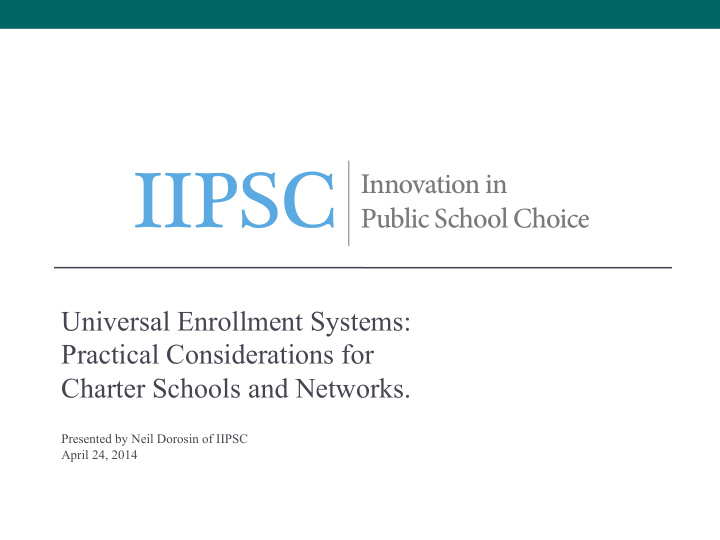



IIPSC Innovation in Public School Choice Universal Enrollment Systems: Practical Considerations for Charter Schools and Networks. Presented by Neil Dorosin of IIPSC April 24, 2014
Agenda 1. IIPSC and Universal Enrollment 2. The case for charter leadership 3. Particularly challenging issues 2
What IIPSC does We design and build healthy enrollment and school choice systems. 1. Assessment 2. Community engagement 3. Market Design 4. Technology 5. Academic research 3
The IIPSC approach Our work is shaped by a strong belief system: 1. Equity, efficiency, and transparency. 2. Political neutrality. 3. Families, and also schools and systems of schools. 4. Rigorous research. 5. Nonprofit. 4
Our expert team has created better enrollment and school choice systems for over 10 years Neil Dorosin, Executive Director, has led Al Roth, Chairman of the Board of IIPSC since 2007. He was previously the Directors, is a Professor of Economics at Director of High School Admissions Stanford and a Professor Emeritus of Operations at the New York City Department Economics and Business Administration at of Education from 2004 – 2007, where Harvard. He shared the 2012 Nobel overhauled and managed NYC DOE’s high memorial prize in Economics for his work school choice process on market design. Parag Pathak, Board Director, is an Atila Abdulkadiroglu, Board Director, is Associate Professor of Economics at MIT and a Professor of Economics at Duke a Research Associate in the NBER’s programs University. His research focuses on on Education, Public Economics and efficient and effective design of student Industrial Organization. His research has admissions systems, as well as, on program directly affected the lives of more than one evaluation in education. million public school students. 5
We have worked with cities and funders across the country Cities : • Chicago • Cleveland ♦ ♦ • Detroit ♦ ♦ ♦ ♦ ♦ • Denver ♦ ♦ • New York • New Orleans • Newark • Rochester • Philadelphia ♦ • Washington, D.C. Funders • The Donnell-Kay Foundation • The Foundation for Newark's Future • The George Gund Foundation • The Michael & Susan Dell Foundation ♦ = IIPSC school district 6 • The Walton Family Foundation
Market design Enrollment as an allocation problem: • Popular seats are scare goods. • Public school seats must be allocated fairly, efficiently, and transparently. • Cannot use price to make allocations – need policy. • Two-sided matching market. • High stakes and multi-faceted competition. • Public interest à healthy market. 7
School choice market failure • Participation is cumbersome à low, and skewed participation. • Multiple offers / no offers. • Extensive use of waitlists. • Late summer “shuffle.” • Match is unstable – improvements are possible but not found. • Congested – takes too long for transactions to come to close. • “Justified envy.” • Lack of accountability. • Schools have to make too big of an investment in enrollment. • Marketing budget has outsized impact. • Schools bend enrollment and choice rules. • Unequal distribution of hard-to-educate kids. • Lots of “gray market” enrollment. • City has no real understanding of demand. • Excess seats, and perhaps excess schools. • Hard to plan the city’s portfolio of schools. • Hostile relationship between sectors. 8
Universal Enrollment Features: 1) One application used for all public schools. 2) High quality information available to all families. 3) Central clearinghouse and state-of-the-art assignment algorithm used to create a match. 4) Safe for families to reveal true preferences. 5) Single best offer system. 6) Efficiency / stability trade-off. 7) Results can be easily explained and are audited. 8) Enrollment as annual cycle, not just one lottery. 9) Demand and enrollment data informs system-wide planning. 9
Agenda 1. IIPSC and Universal Enrollment 2. The case for charter leadership 3. Particularly challenging issues 10
Charter schools should drive this work It’s good for your school: • Real demand data. • Match quality. • Your rights are protected. • Register stability. • Immunity from false accusations. • Reduced administrative burden. • Frees up resources. 11
Charter schools should drive this work It advances education reform: • Maximizes access and choice for families. • Enrollment policies are actually implemented. • Facilitates competition. • Collaboration across sectors. • Robust and accurate data. • Clarifies “education production” results. • Allows for wisdom in portfolio planning. 12
Agenda 1. IIPSC and Universal Enrollment 2. The case for charter leadership 3. Particularly challenging issues 13
Governance Who administrates a Universal Enrollment system, and who is accountable? School district as administrative body: • Denver, New Orleans, Newark, New York City Another entity as administrative body: • Washington DC 14
Admissions priority policy Charters are separate from district schools: • Neighborhood and geography. • Socio-economic status and other “set-asides.” • Prioritizing families who understand school theme. • Selective criteria. 15
Capacity and utilization How many seats are available? How will available seats be used? • Caps on enrollment. • Internal structure of grades and classes. • Students who arrive mid-year. • Weighted student funding. 16
Promotion, suspension, expulsion Individual versus standard criteria. 17
Contact Information Neil Dorosin Founder and Executive Director (New York) www.iipsc.org Mobile: (917) 579-8691 Desk: (347) 529-5970 Email: neild@iipsc.org 18
Recommend
More recommend